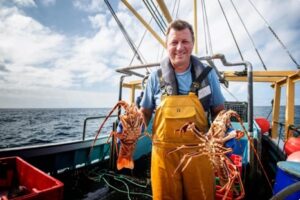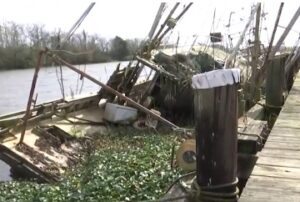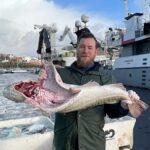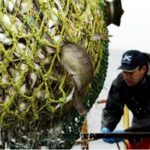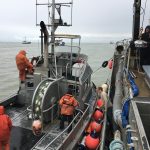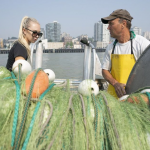Search Results for: Pacific Sardine
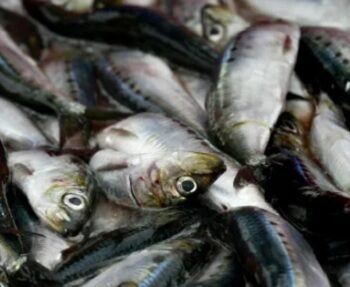
The sardine war hits a lull: Commercial fishing industry lands a victory in Pacific sardine management
The Pacific Fishery Management Council, which oversees fishing of Pacific sardines, voted unanimously in September to maintain the current sardine fishery management process that calls for reassessments after each year’s stock assessments. At the moment, the direct commercial sardine fishery is closed. “Fishery managers have failed to learn from the mistakes of history,” said Geoff Shester, senior scientist at marine conservation group Oceana,,, Diane Pleschner-Steele, executive director of the California Wetfish Producers Association, argues that sardines are not overfished and “the Council’s unanimous decision shows that they understand reality, the big picture.” >click to read< 14:27
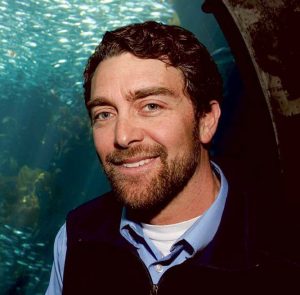
As the Pacific sardine population keeps dropping, the feds come under scrutiny
On April 8, the Pacific Fishery Management Council – a body of appointed officials that regulates fisheries off the West Coast – will be presented with the draft assessment of the sardine population from roughly southern California to Canada. The news it brings is neither good for fishermen nor the local marine ecosystem: The estimated number of sardines in July 2018 – which dictates policy for the 2018-19 fishing year – is 52,065 metric tons, an approximately 97-percent drop from 2006, the most recent peak. What is in dispute: the accuracy of the population assessment, and how we got here.>click to read<15:30
Pacific sardine fishery closed for the third year in a row
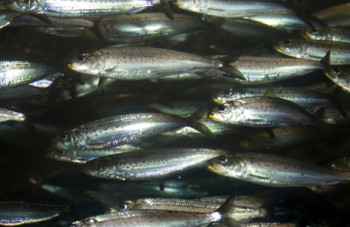 The Pacific Fishery Management Council on April 10 announced the continued closure of the Pacific sardine directed fishery through June 30, 2018. This is the third annual closure in a row for this fishery. Council members heard from scientists that the abundance forecast for the 2017-18 season, scheduled to start July 1, was significantly below the 150,000 metric ton threshold for a directed fishery. They also considered testimony from fishery participants and environmental groups before reaching a decision to close the directed fishery. click here to read the story 19:33
The Pacific Fishery Management Council on April 10 announced the continued closure of the Pacific sardine directed fishery through June 30, 2018. This is the third annual closure in a row for this fishery. Council members heard from scientists that the abundance forecast for the 2017-18 season, scheduled to start July 1, was significantly below the 150,000 metric ton threshold for a directed fishery. They also considered testimony from fishery participants and environmental groups before reaching a decision to close the directed fishery. click here to read the story 19:33
Pacific sardine population remains low, says National Marine Fisheries Service
 A study released Friday by the National Marine Fisheries Service puts the northern Pacific sardine population off the West Coast at perilously low levels for the third straight year. The findings, which will be reviewed next month by The Pacific Fishery Management Council, while disheartening for both environmentalists and fishermen, are also disputed by some in the fishing industry who question the method by which these forage fish are counted.,, But Diane Pleschner-Steele, who is the executive director of the California Wetfish Producers Association and represents the majority of boat fishermen and processors who harvest wetfish, said that there’s significant error in the way the sardines are counted and that current government surveys are not surveying adequately the fish that are in the near shore ocean. “Closing the sardine fishery basically closes everything for us, except for squid,” said Pleschner-Steele. “We are seriously considering applying for disaster relief.” read the article here 09:26:19
A study released Friday by the National Marine Fisheries Service puts the northern Pacific sardine population off the West Coast at perilously low levels for the third straight year. The findings, which will be reviewed next month by The Pacific Fishery Management Council, while disheartening for both environmentalists and fishermen, are also disputed by some in the fishing industry who question the method by which these forage fish are counted.,, But Diane Pleschner-Steele, who is the executive director of the California Wetfish Producers Association and represents the majority of boat fishermen and processors who harvest wetfish, said that there’s significant error in the way the sardines are counted and that current government surveys are not surveying adequately the fish that are in the near shore ocean. “Closing the sardine fishery basically closes everything for us, except for squid,” said Pleschner-Steele. “We are seriously considering applying for disaster relief.” read the article here 09:26:19
D.B. Pleschner: Pacific Sardines are not collapsing, may be in recovery
 On April 10, the Pacific Fishery Management Council closed the West Coast sardine fishery for a second straight year. The council followed its ultra-conservative harvest control policy and relied on a stock assessment that does not account for recent sardine recruitment. But in fact, there are multiple lines of evidence that young sardines are now abundant in the ocean. In addition to field surveys, fishermen in both California and the Pacific Northwest have been observing sardines – both small and large — since the summer of 2015. And California fishermen also provided samples of the small fish to federal and state fishery managers. Read the rest here 19:29
On April 10, the Pacific Fishery Management Council closed the West Coast sardine fishery for a second straight year. The council followed its ultra-conservative harvest control policy and relied on a stock assessment that does not account for recent sardine recruitment. But in fact, there are multiple lines of evidence that young sardines are now abundant in the ocean. In addition to field surveys, fishermen in both California and the Pacific Northwest have been observing sardines – both small and large — since the summer of 2015. And California fishermen also provided samples of the small fish to federal and state fishery managers. Read the rest here 19:29
As Pacific sardine collapse worsens, scientists worry about possible ripple in the ecosystem
 Nearly a year into a West Coast sardine fishing ban enacted to protect the collapsing population, the fish formerly worth more than $8 million to Oregon’s economy have shown no signs of a comeback. New federal research indicates numbers of the small, silvery, schooling fish have plummeted further than before the fishing moratorium, dashing any hope of lifting it in 2016. With the current sardine population hovering at 7 percent of its 2007 peak, fishermen now say they expect to wait a decade or more to revive the fishery. “I don’t want to take a pessimistic view, but I would think we’ll be shut down until 2030,” said Ryan Kapp, a Bellingham, Washington, fisherman who advises the Pacific Fishery Management Council on sardines and other fish. Read the article here 15:33
Nearly a year into a West Coast sardine fishing ban enacted to protect the collapsing population, the fish formerly worth more than $8 million to Oregon’s economy have shown no signs of a comeback. New federal research indicates numbers of the small, silvery, schooling fish have plummeted further than before the fishing moratorium, dashing any hope of lifting it in 2016. With the current sardine population hovering at 7 percent of its 2007 peak, fishermen now say they expect to wait a decade or more to revive the fishery. “I don’t want to take a pessimistic view, but I would think we’ll be shut down until 2030,” said Ryan Kapp, a Bellingham, Washington, fisherman who advises the Pacific Fishery Management Council on sardines and other fish. Read the article here 15:33
Pacific sardine industry shutdown looms as species collapses – Council Action Expected Sunday
 Pacific coast sardines are facing a population collapse so severe that Oregon’s multimillion-dollar sardine industry almost certainly will be shut down this summer. The Pacific Fishery Management Council, which regulates the fishing industry off the coast of Oregon, California and Washington, is expected to vote Sunday to close the West Coast sardine fishery in response to new population estimates that indicate the species’ still hasn’t emerged from an eight-year plummet. Read the rest here, and read the comments. Amazing 19:21
Pacific coast sardines are facing a population collapse so severe that Oregon’s multimillion-dollar sardine industry almost certainly will be shut down this summer. The Pacific Fishery Management Council, which regulates the fishing industry off the coast of Oregon, California and Washington, is expected to vote Sunday to close the West Coast sardine fishery in response to new population estimates that indicate the species’ still hasn’t emerged from an eight-year plummet. Read the rest here, and read the comments. Amazing 19:21
Higher Pacific sardine limits urged over environmental objections
 The higher limits were proposed unanimously by the 14-member Pacific Fishery Management Council, one of eight advisory panels around the country that oversee commercial and recreational fishing for U.S. waters in their regions. Read the rest here 09:55
The higher limits were proposed unanimously by the 14-member Pacific Fishery Management Council, one of eight advisory panels around the country that oversee commercial and recreational fishing for U.S. waters in their regions. Read the rest here 09:55
Viewpoints: The state of Pacific sardine populations
Sardines have been a hot news topic in recent weeks. Environmental groups and others have trumpeted that the sardine population is collapsing like it did in the mid-1940s. The environmental group Oceana has been arguing this point loudly in order to shut down the sardine fishery. That’s why it filed suit in federal court, in a case now under appeal, challenging the current sardine management. Read more here Sacbee 16:55
Indepth – A controversial decision: Fishery Managers Scale Back 2014 Pacific Sardine Harvest
 A controversial decision by the Pacific Fishery Management Council (PFMC) would set catch limits during the initial phase of the 2014 Pacific sardine season well below traditional recommendations. more@fishermensnews 17:10
A controversial decision by the Pacific Fishery Management Council (PFMC) would set catch limits during the initial phase of the 2014 Pacific sardine season well below traditional recommendations. more@fishermensnews 17:10
Pacific Fishery Management Council votes to halt this seasons West Coast sardine fishery as soon as possible
 Meeting outside Santa Rosa, California, the Pacific Fishery Management Council voted to halt the current season as early as possible, affecting about 100 fishing boats. The season normally would end June 30. Earlier this week, the council shut down the next sardine season, which was set to begin July 1. The council did not take Wednesday’s decision lightly and understood the pain the closure would impose on the fishing industry, said council member Michele Culver, representing the Washington Department of Fish and Wildlife. Read the rest here 22:15
Meeting outside Santa Rosa, California, the Pacific Fishery Management Council voted to halt the current season as early as possible, affecting about 100 fishing boats. The season normally would end June 30. Earlier this week, the council shut down the next sardine season, which was set to begin July 1. The council did not take Wednesday’s decision lightly and understood the pain the closure would impose on the fishing industry, said council member Michele Culver, representing the Washington Department of Fish and Wildlife. Read the rest here 22:15
Pacific Fishery Management Council slash’s sardine harvest along West Coast
 The Pacific Fishery Management Council voted 7-6 Sunday in Costa Mesa, Calif., to set the commercial harvest level for California, Oregon and Washington at 5,446 metric tons for the first six months of 2014, down from 18,073 metric tons for the same period in 2013. more@redbluffdailynews 11:51
The Pacific Fishery Management Council voted 7-6 Sunday in Costa Mesa, Calif., to set the commercial harvest level for California, Oregon and Washington at 5,446 metric tons for the first six months of 2014, down from 18,073 metric tons for the same period in 2013. more@redbluffdailynews 11:51
Pacific Fishery Management Council – deep cuts for Sardines
 The decline in West Coast sardine populations saw regulators on Sunday approve sharp cuts on commercial fishing for the species in 2014. The Pacific Fishery Management Council set a catch limit of 29,770 metric tons for 2014 – less than half the limit last year. Stay tuned. 21:33
The decline in West Coast sardine populations saw regulators on Sunday approve sharp cuts on commercial fishing for the species in 2014. The Pacific Fishery Management Council set a catch limit of 29,770 metric tons for 2014 – less than half the limit last year. Stay tuned. 21:33
Sardine fishery quota slashed for 2013, but worries remain.- Oceana, “It is frankly unbelievable”, Pacific Fishery Management Council – catch levels will be lower in 2013
While catch levels will be lower in 2013 than in 2012, the fishery council ignored increasing catch rates by Canada and Mexico; ignored warnings from scientists that the stock is collapsing; and failed to account for the importance of sardines as prey for whales, seabirds and other fish like salmon and tuna, Oceana wrote. http://fis.com/fis/worldnews/worldnews.asp?l=e&ndb=1&id=57017
I think OCEANA are the ones ignoring increasing catch rates by Canada and Mexico, and should refocus on the problem. If there is a problem.
“A Total Shock” – Japanese Sardines Detected in U.S. Waters
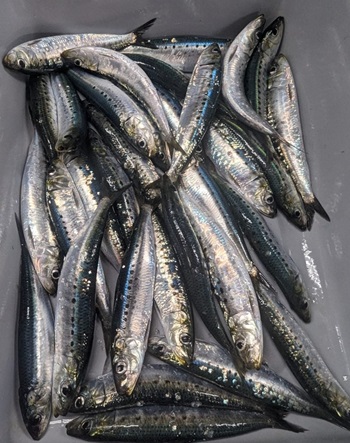 Genomic sequencing of Pacific sardines in 2022 and 2023 uncovered the presence of not just one, but two distinct sardine species in the California Current. When research scientist Gary Longo first reviewed the results of his genomic analysis of sardines, he thought he must have mixed up his samples. Besides the Pacific sardines common on the West Coast, many of the fish appeared to be another species. “It was a total shock,” he said. Then he compared their genetic code to other known species. “That was the ‘aha moment’ when we realized we were looking at a second species of sardine.” The analysis shows that of the 345 sardine samples collected during NOAA Fisheries’ 2021 and 2022 Coastal Pelagic Species Surveys, all of the fish in 2021 were Pacific sardines, but those collected in 2022 were a mix of Pacific sardines and Japanese sardines. more, >>CLICK TO READ<< 10:50
Genomic sequencing of Pacific sardines in 2022 and 2023 uncovered the presence of not just one, but two distinct sardine species in the California Current. When research scientist Gary Longo first reviewed the results of his genomic analysis of sardines, he thought he must have mixed up his samples. Besides the Pacific sardines common on the West Coast, many of the fish appeared to be another species. “It was a total shock,” he said. Then he compared their genetic code to other known species. “That was the ‘aha moment’ when we realized we were looking at a second species of sardine.” The analysis shows that of the 345 sardine samples collected during NOAA Fisheries’ 2021 and 2022 Coastal Pelagic Species Surveys, all of the fish in 2021 were Pacific sardines, but those collected in 2022 were a mix of Pacific sardines and Japanese sardines. more, >>CLICK TO READ<< 10:50
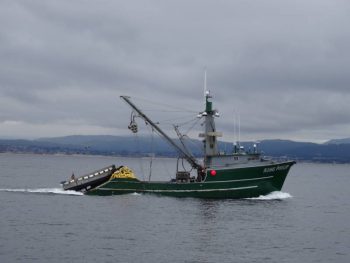
PFMC Officials: No Sardine Fishing Off California This Year Due to Steep Population Decline
West coast regulators have voted unanimously to ban commercial sardine fishing for the fifth straight year after a recent evaluation of the northern Pacific stock revealed a steep decline. The ban on commercial sardine catch spans the entire length of the U.S. West Coast.,,, A new assessment of northern Pacific sardine stocks by the National Oceanic and Atmospheric Administration (NOAA).,,, Not all fishermen agree with the decision to keep the sardine fishery shuttered. Diane Pleschner-Steele, executive director- California Wetfish Producers Association, said NOAA’s sardine survey under-counts the fish, and that the fishermen she hears from are noticing a comeback. >click to read<10:59
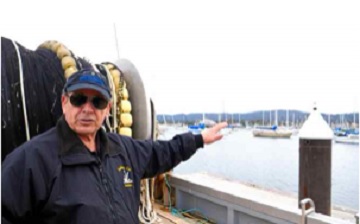
Fishermen know the truth about sardines
Reporter Anne Roth quoted me in her article “When will sardines return? Not any time soon say scientists.” But she misunderstood what I said. I’m one of the fishermen Diane Pleschner-Steele quoted in her comment, “Fishermen are seeing more sardines, not less.” I’ve been fishing for 60 years, and I’ve seen sardines come, go and come back again. But the government surveys that assess the biomass don’t come into coastal waters where the fish are now. In fact, we began seeing an abundance of small sardines right before the 2015 El Niño. Aniello Guglielmo, Monterey >click to read< for more articles on this issue, >click to read<12:19

California Wetfish Producers Association: Sardine Fishery Collapse Latest Fake News
This Sunday, April 8, the Pacific Fishery Management Council is meeting in Portland to debate the fate of the West Coast sardine fishery, after the 2018 sardine stock assessment estimated the biomass has declined by 97 percent since 2006. According to the California Wetfish Producers Association, the only problem with that finding is it belies reality. “Fishermen are seeing more sardines, not less, especially in nearshore waters. And they’ve been seeing this population spike for several years now,” said Diane Pleschner-Steele, executive director of the California Wetfish Producers Association (CWPA). “This stock assessment was an update that was not allowed to include any new methods and was based primarily on a single acoustic survey,,, >click to read<21:15
West Coast sardine fishery shutdown continues for 2nd year
 West coast sardine fishermen for a second straight season will have to keep their boats moored or find something else to catch. The Pacific Fishery Management Council on Sunday closed the sardine fishery off Oregon, California and Washington following the second straight year of sardine population estimates that fall below the minimum abundance required to allow fishing. There are fewer than 65,000 metric tons adult sardines in the ocean this year, federal scientists estimated. West coast fishery rules require sardine fishing to cease once the adult stock drops below 150,000 metric tons. Read the article here 11:58
West coast sardine fishermen for a second straight season will have to keep their boats moored or find something else to catch. The Pacific Fishery Management Council on Sunday closed the sardine fishery off Oregon, California and Washington following the second straight year of sardine population estimates that fall below the minimum abundance required to allow fishing. There are fewer than 65,000 metric tons adult sardines in the ocean this year, federal scientists estimated. West coast fishery rules require sardine fishing to cease once the adult stock drops below 150,000 metric tons. Read the article here 11:58
West Coast sardine populations, long sinking, look even worse in forecast
 Sardines off the West Coast have continued on a steep decline, with populations this summer forecast to be down 93 percent from a 2007 peak, according to a draft assessment from the National Marine Fisheries Service. The sardines are a key forage food for sea lions, salmon and many other species, as well as a source of income for commercial fishermen. Last year, the sardine implosion was so severe that the Pacific Fishery Management Council voted to call off the season that was scheduled to start in July for West Coast fleets, including those in Washington state. Oceana shrew Geoff Shester throws his dogma into the conversation. Read the rest here 13:33
Sardines off the West Coast have continued on a steep decline, with populations this summer forecast to be down 93 percent from a 2007 peak, according to a draft assessment from the National Marine Fisheries Service. The sardines are a key forage food for sea lions, salmon and many other species, as well as a source of income for commercial fishermen. Last year, the sardine implosion was so severe that the Pacific Fishery Management Council voted to call off the season that was scheduled to start in July for West Coast fleets, including those in Washington state. Oceana shrew Geoff Shester throws his dogma into the conversation. Read the rest here 13:33
West Coast sardine decline: Science vs. politics, By D.B. Pleschner
 The federal Pacific Fishery Management Council has shut down the remainder of the current sardine season and has canceled the 2015-16 fishing season altogether. Fishermen supported this action. Why the closure? According to environmental groups like Oceana, it was to stop overfishing and save starving sea lions deprived of essential sardines. Neither reason is true, but many in the media have trumpeted this hyperbole put forth by groups whose political agenda is to shut down fishing completely. Read the rest here 08:40
The federal Pacific Fishery Management Council has shut down the remainder of the current sardine season and has canceled the 2015-16 fishing season altogether. Fishermen supported this action. Why the closure? According to environmental groups like Oceana, it was to stop overfishing and save starving sea lions deprived of essential sardines. Neither reason is true, but many in the media have trumpeted this hyperbole put forth by groups whose political agenda is to shut down fishing completely. Read the rest here 08:40
Another View: Sardine population isn’t crashing by D.B. Pleschner
 Environmental groups such as Oceana complain that the sardine population is collapsing just as it did in the mid-1940s. They blame “overfishing” as the reason and maintain that the fishery should be shut down completely (“Starving sea lions spotlight overfishing,” Viewpoints, April 14). In truth, Pacific sardines are perhaps the best-managed fishery in the world. The current rule – established in 2000 and updated last year with more accurate science – sets a strict harvest guideline. Read the rest here 10:25
Environmental groups such as Oceana complain that the sardine population is collapsing just as it did in the mid-1940s. They blame “overfishing” as the reason and maintain that the fishery should be shut down completely (“Starving sea lions spotlight overfishing,” Viewpoints, April 14). In truth, Pacific sardines are perhaps the best-managed fishery in the world. The current rule – established in 2000 and updated last year with more accurate science – sets a strict harvest guideline. Read the rest here 10:25
Oceana’s Geoffrey Shester says NOAA fails to connect the dots to Sardine overfishing, pushing the stock over the edge
 History repeats as the Pacific sardine population collapses and California’s iconic ocean wildlife feels the impacts. The Pacific sardine population has collapsed 90 percent since 2007 and the fishery has been overfishing during this decline. As a result, (overpopulated) sea lions and seabirds are starving and one of California’s most lucrative fisheries must soon shut down. Read the rest here 08:02
History repeats as the Pacific sardine population collapses and California’s iconic ocean wildlife feels the impacts. The Pacific sardine population has collapsed 90 percent since 2007 and the fishery has been overfishing during this decline. As a result, (overpopulated) sea lions and seabirds are starving and one of California’s most lucrative fisheries must soon shut down. Read the rest here 08:02
D.B. Pleschner: Sardines are not being overfished
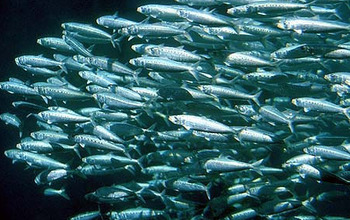 In recent weeks, sardines have been a hot news topic again. Environmental groups like Oceana complain that the sardine population is collapsing just like it did in the mid-1940s. They blame “overfishing” as the reason and maintain that the fishery should be shut down completely. Today, in truth, Pacific sardines are perhaps the best-managed fishery in the world — the poster fish for effective ecosystem-based management,,, Read the rest here 08:50
In recent weeks, sardines have been a hot news topic again. Environmental groups like Oceana complain that the sardine population is collapsing just like it did in the mid-1940s. They blame “overfishing” as the reason and maintain that the fishery should be shut down completely. Today, in truth, Pacific sardines are perhaps the best-managed fishery in the world — the poster fish for effective ecosystem-based management,,, Read the rest here 08:50
Con Group Oceana wants West Coast Sardine Fishing shut down immediately!
 West Coast fisheries managers will likely shut down sardine fishing this year in the face of evidence that the stock is declining. The commercial fishing fleet hopes that the Pacific Fishery Management Council will not be so concerned that they shut down other fisheries, such as mackerel and anchovies. However, the conservation group Oceana wants an immediate shut down. The group says this would leave food in the ocean for sea lions and other wildlife and speed the rebuilding process for sardines. Read the rest here 13:43
West Coast fisheries managers will likely shut down sardine fishing this year in the face of evidence that the stock is declining. The commercial fishing fleet hopes that the Pacific Fishery Management Council will not be so concerned that they shut down other fisheries, such as mackerel and anchovies. However, the conservation group Oceana wants an immediate shut down. The group says this would leave food in the ocean for sea lions and other wildlife and speed the rebuilding process for sardines. Read the rest here 13:43
Oceana blame’s sardine overfishing, not just warmer waters, for sea lion deaths.
 But marine conservation nonprofit Oceana, which has a California office in Monterey’s Heritage Harbor, connects another dot to the scarcity of sea lion food: sardine fishing. The Pacific Coast sardine population is at its lowest level in 15 years, Oceana reports. “Any fishing on Pacific sardine right now is overfishing,” said Geoff Shester, Oceana California campaign director. “While federal officials are quick to blame ocean conditions for the declines in [sea lion] prey, they have turned a blind eye to the effects of sardine fishing,,, Read the rest here 07:44
But marine conservation nonprofit Oceana, which has a California office in Monterey’s Heritage Harbor, connects another dot to the scarcity of sea lion food: sardine fishing. The Pacific Coast sardine population is at its lowest level in 15 years, Oceana reports. “Any fishing on Pacific sardine right now is overfishing,” said Geoff Shester, Oceana California campaign director. “While federal officials are quick to blame ocean conditions for the declines in [sea lion] prey, they have turned a blind eye to the effects of sardine fishing,,, Read the rest here 07:44
Winchester Bay, Thar be sardines here
 “In our minds,” he said, “fish buyers, fishermen in the sardine industry … we get a quota and it keeps getting reduced. We don’t think NOAA (National Oceanic and Atmospheric Administration) does a very good job doing their science. In fact, we use airplanes to see our fish. “We may not get a July 1 season this year,” he explained, “because they say there’s no fish in the ocean. So, we happened to be down here buying live crab from the local guys, here, and they’ve been telling me ‘we’re seeing sardines.’ I’m saying ‘no you aren’t. They’re not here.’ ‘No, we’re seeing sardines.’” Read the rest here 12:46
“In our minds,” he said, “fish buyers, fishermen in the sardine industry … we get a quota and it keeps getting reduced. We don’t think NOAA (National Oceanic and Atmospheric Administration) does a very good job doing their science. In fact, we use airplanes to see our fish. “We may not get a July 1 season this year,” he explained, “because they say there’s no fish in the ocean. So, we happened to be down here buying live crab from the local guys, here, and they’ve been telling me ‘we’re seeing sardines.’ I’m saying ‘no you aren’t. They’re not here.’ ‘No, we’re seeing sardines.’” Read the rest here 12:46
Sardine ban looms as fishermen weigh disaster funds –
With the number of sardines along the Pacific coast plummeting, a commercial fishing ban looms on Monterey’s most iconic fish. “Our fishing is making the crash so much worse than it would have naturally been,” said Geoff Shester, California program director for the advocacy group Oceana. “This is unquestionably and unequivocally a result of overfishing.” “I’m sure Oceana will be banging the drum saying, ‘Oh no, the sky is falling, you can’t take one more fish,’” Diane Pleschner-Steele (CWPA) said. “They’re just so off the wall. They’re incredible.” Read the rest here 08:05
Forage fish management key to protecting Pacific Ocean ecosystem health
Pacific sardine populations have shown an alarming decline in recent years, and some evidence suggests anchovy and herring populations may be dropping as well. The declines could push fishermen toward other currently unmanaged “forage fish,” Read more here 10:35 The Forage Fish Farce
West Coast: Sardines vanish from coastal waters; squid and anchovy fill the void for fishermen
Larry Derr was as prepared as any longtime Southern California bait fisherman for the disappearance of the Pacific sardines he has pulled up by the ton since the 1980s. He can fish anchovies instead and, if those become scarce, there’s been a local surge in market squid to keep him in business. Read more@dailybreeze 18:20
































